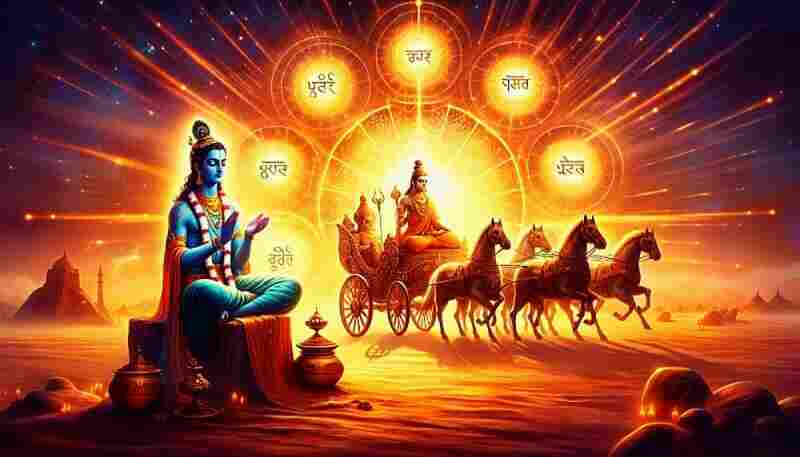Are you struggling to find peace of mind in your busy life?
In today’s fast-paced world, our mind often gets lost in endless thoughts. Worries, stress, and uncertainty about the future slowly eat us from within.
At such times, we need guidance that not only calms the mind but also shows us the true meaning of life. This wisdom has been expressed in the Bhagavad Gita. But before diving into this ocean of wisdom, how should we prepare our minds?
The answer is Gita Dhyana. The nine verses of Gita Dhyana ready our mind and heart to receive the wisdom of the Gita. Gita Dhyana is the gateway to the Bhagavad Gita.
This article will explain every verse of Gita Dhyana, showing not just the words but also the wisdom and its value in our daily life.
So, let us begin this spiritual journey!
What Is Gita Dhyana?
Many people think that Gita Dhyana is a part of the 700 verses of the Bhagavad Gita. But interestingly, that is not true! Gita Dhyana is actually a hymn of 9 verses, recited before the part of the Gita. It is also called the “invocation” or “prayer” of the Gita.
People believe that Madhusudana Saraswati, a famous Advaita Vedanta teacher, wrote these verses in the 15th century. The purpose of this Dhyana is to focus the mind, awaken devotion, and make oneself ready to receive the wisdom of the Gita.
Here is a simple example: Just as a musician tunes his instrument before a concert, or a runner warms up before a race, in the same way, Gita Dhyana is the tuning and warm-up of our mind. It prepares us to connect with the higher thoughts of the Gita.
Why Gita Dhyana Comes First?
You may wonder, “Why not start reading the chapters of the Gita directly? Why are these Dhyana verses needed?”
The answer lies in their importance.
- Mental Focus: These verses bring before our mind the background of the Gita, its importance, and its sources (Lord Krishna and Sage Vyasa). IIt
- Growth of Faith and Devotion: The verses express gratitude and respect towards the Gita, Lord Krishna, and Sage Vyasa. Reciting them awakens faith and devotion in our hearts.
- Creating the Right Attitude: The Gita is not just a book—it is a dialogue and a teaching. Gita Dhyana builds a humble attitude in us: “I am here to learn and transform my life.”
- A Shield of Energy: By chanting these verses, a circle of positive energy is formed around us. It protects us from outside distractions and helps us remain fully engaged in the study of the Gita.
Simple Meanings of Each Verse:
Now, let us uncover the hidden gems within every verse of Gita Dhyana. We will understand both the simple meaning of each verse and the message behind it.
Verse 1: Introduction and Reverence to the Gita
Sanskrit Verse:
ॐ पार्थाय प्रतिबोधितां भगवता नारायणेन स्वयं
व्यासेन ग्रथितां पुराणमुनिना मध्येमहाभारतम् ।
अद्वैतामृतवर्षिणीं भगवतीमष्टादशाध्यायिनीम्
अम्ब त्वामनुसंदधामि भगवद्गीते भवद्वेषिणीम् ॥ १ ॥
Simple Meaning:
Om! The Gita, taught by Lord Krishna to Arjuna, was written into the Mahabharata by Sage Vyasa. It showers the nectar of Advaita (non-dual wisdom), contains eighteen chapters, and destroys the bondage of worldly life. O Mother Bhagavad Gita! I meditate upon you daily.
Deeper Meaning and Teachings:
This very first verse is like the “introduction” or “identity card” of the entire Gita.
- “Parthaya Pratibodhitam” –
- Who is the Gita for? It is for Partha, not only Arjuna, but also for each one of us, confused in the battlefield of life, caught between duty and emotions.
- “Narayana Svayam” –
- This is not the teaching of an ordinary person. It is the wisdom given by Narayana, the Supreme Being Himself. That makes its value immeasurable.
- “Vyasena Grathitam” –
- Sage Vyasa carefully placed this divine wisdom in the Mahabharata, much like setting a precious jewel at the centre of a grand painting.
- “Advaitamrita Varshinim” –
- The Gita showers the nectar of Advaita, teaching that everything is one Brahman, not separate. It shows us the path to immortality.
- “Bhava-Dveshinim” –
- Bhava means worldly existence, and Dveshini means destroyer. The Gita frees us from the cycle of birth and death, from worldly sorrows. That is why it is called Mother, who protects and guides her children.
Relevance in Today’s Life:
It reminds us that God’s guidance is there whenever life feels confusing. We need the willingness to open our hearts and receive it.
Verse 2: Salutations to Sage Vyasa
Sanskrit Verse:
नमो ऽस्तु ते व्यास विशालबुद्धे फुल्लारविन्दायतपत्रनेत्र ।
येन त्वया भारततैलपूर्णः प्रज्वालितो ज्ञानमयः प्रदीपः ॥ २ ॥
Simple Meaning:
Salutations to Sage Vyasa, whose wisdom is vast and whose eyes are like the petals of a fully bloomed lotus. You have lit the lamp of knowledge, using the Mahabharata as the oil that keeps it burning.
Deeper Meaning and Teachings:
Shri Krishna gave the knowledge of the Gita, and Sage Vyasa brought it to us. This verse expresses deep gratitude to that great teacher.
- “Vishala-Buddhe” (Great Intelligence):
- Think of how vast the wisdom of Vyasa must have been! He not only composed the Mahabharata, but also the Puranas and the Brahma Sutras.
- “Bharata-Taila Purnah … Jnanamayah Pradipah” (Lamp of Knowledge):
- This is a beautiful metaphor. The Mahabharata is the oil, and the Gita is the lamp of knowledge. Vyasa used the story of the Mahabharata as oil to light the lamp of the Gita, which still removes the darkness of ignorance today. A lamp needs oil to burn, just as the Gita needs the Mahabharata for understanding.
Relevance in Today’s Life:
This verse teaches us the value of knowledge and the importance of the teacher who brings that knowledge to us. We should remain grateful to our teachers, parents, and guides, for they are the ones who light the lamp of wisdom in our lives.
Verse 3: Salutations to Lord Krishna
Sanskrit Verse:
प्रपन्नपारिजाताय तोत्रवेत्रैकपाणये । ज्ञानमुद्राय कृष्णाय गीतामृतदुहे नमः ॥ ३ ॥
Simple Meaning:
Salutations to Lord Krishna, who is like the wish-fulfilling tree for those who surrender to Him. In one hand, He holds a whip for guiding the horses, and in the other, He shows the gesture of knowledge. To Him, who brought forth the nectar of the Gita, I bow down.
Deeper Meaning and Teachings:
This verse describes three beautiful forms of Krishna, showing His complete personality.
- “Prapanna-Parijatay” (Wish-fulfilling Tree):
- For those who surrender, He fulfils all desires. It shows His loving and protective nature toward devotees.
- “Totra-Vetraika-Panaye” (The Charioteer):
- He holds the whip in His hand. He is the charioteer of Arjuna, and the charioteer of our lives too. He pulls the reins at the right time to save us from going astray.
- “Jnana-Mudraya” (The Teacher of Wisdom):
- He is the supreme knower, the world’s true teacher. He not only shows the way—He Himself is the way.
- “Gita-Amrita-Duhe” (The Milker of Nectar):
- Like milking a cow, He drew out the nectar of wisdom from the Gita for the good of all.
Relevance in Today’s Life:
This verse teaches us that when we surrender to God with faith, He takes charge of our lives, guides us on the right path, and blesses us with the light of knowledge.
Verse 4: The Gita’s Nectar of Wisdom
Sanskrit Verse:
सर्वोपनिषदो गावो दोग्धा गोपालनन्दनः । पार्थो वत्सः सुधीर्भोक्ता दुग्धं गीतामृतं महत् ॥ ४ ॥
Simple Meaning:
All the Upanishads are like cows. Krishna, the son of the cowherd, is the one who milks them. Arjuna is the calf, and wise people are the ones who drink the great nectar of the Gita, like milk.
Deeper Meaning and Teachings:
It is one of the most beautiful and well-known metaphors in the Gita Dhyana.
- Upanishads as Cows:
- The core of Indian philosophy is rooted in the Upanishads. They are the source of knowledge.
- Krishna as the Milker:
- It is hard to understand the wisdom of the Upanishads. Krishna drew out their essence and presented it simply in the form of the Gita.
- Arjuna as the Calf:
- Just as a cow gives milk for its calf, Krishna revealed this wisdom because of Arjuna’s questions and curiosity. Arjuna became the medium.
- Wise Seekers as the Drinkers:
- This wisdom is not only for Arjuna. Anyone who approaches the Gita with faith and pure understanding can drink this nectar of knowledge.
Relevance in Today’s Life:
This verse teaches us to ask questions and remain curious. Like Arjuna, when we humbly ask with an open heart, we too receive the nectar of wisdom.
Verse 5: Salutations to the Divine Form of Krishna
Sanskrit Verse:
वसुदेवसुतं देवं कंसचाणूरमर्दनम् ।
देवकीपरमानन्दं कृष्णं वन्दे जगद्गुरुम् ॥ ५ ॥
Simple Meaning:
I bow to Lord Krishna, the son of Vasudeva, the destroyer of demons like Kansa and Chanura, the one who gave great joy to Devaki, and the Supreme Teacher of the world.
Deeper Meaning and Teachings:
This verse illustrates both the human and divine aspects of Krishna.
- Human Side:
- He is the son of Vasudeva and the source of happiness for His mother, Devaki. It highlights His family bonds and emotional ties.
- Divine Side:
- He is the destroyer of evil (“Kansa-Chanura-Mardanam”) and the Jagadguru—the eternal teacher of the world.
- This verse reveals that when God takes an incarnation, He lives in human relationships with love, while also fulfilling His divine mission. He destroys evil and protects the good. It is the essence of the Gita’s verse: “Paritrāṇāya sādhūnām, vināśhāyacha duṣkṛutām”—to protect the righteous and destroy the wicked.
Relevance in Today’s Life:
In our lives, too, we play many roles—son, daughter, parent, professional. Like Krishna, we should learn to balance all our responsibilities with wisdom and live according to dharma.
Verse 6: The River Metaphor of the Mahabharata War
Sanskrit Verse:
भीष्मद्रोणतटा जयद्रथजला गान्धारनीलोपला ।
शल्यग्राहवती कृपेण वहनी कर्णेन वेलाकुला ॥
अश्वत्थामविकर्णघोरमकरा दुर्योधनावर्तिनी ।
सोत्तीर्णा खलु पाण्डवै रणनदी कैवर्तकः केशवः ॥ ६ ॥
Simple Meaning:
The Great War was a fierce river. Its banks were Bhishma and Drona, its water was Jayadratha, its blue stones were Shakuni, its great fish was Shalya, its current was Kripacharya, and its waves were Karna. The terrifying crocodiles were Ashwatthama and Vikarna, and the whirlpool was Duryodhana. Yet the Pandavas crossed this dreadful river of battle because their boatman was none other than Lord Krishna.
Deeper Meaning and Teachings:
It is a powerful and poetic metaphor, painting a vivid picture of the Mahabharata war.
- River as Life or Crisis:
- Life, or any great crisis, is like a turbulent river full of dangers—wild creatures, whirlpools, and sharp rocks.
- Kaurava Warriors as Dangers:
- Each Kaurava warrior represents one danger in the river. Bhishma and Drona were like impossible banks. Duryodhana was the whirlpool pulling everything in.
- Krishna as the Boatman:
- The Pandavas could cross safely because they had the greatest boatman—Krishna. With Krishna’s guidance, a person can cross even life’s troubles.
Relevance in Today’s Life:
Our own life is also like such a river of challenges. Problems at work, struggles in relationships, and financial worries are like the dangers in a river. But if we hand over the boat of our life to Krishna—that is, to dharma and wisdom—we too can cross the river successfully.
Verse 7: The Metaphor of the Mahabharata as a Lotus
Sanskrit Verse:
पाराशर्यवचःसरोजममलं गीतार्थगन्धोत्कटम् । नानाख्यानककेसरं हरिकथासंबोधनाबोधितम् ॥ लोके सज्जनषट्पदैरहरहः पेपीयमानं मुदा । भूयाद्भारतपंकजं कलिमलप्रध्वंसि नः श्रेयसे ॥ ७ ॥
Simple Meaning:
The Mahabharata is like a lotus blooming in the clear lake of Sage Vyasa’s words. Its strong fragrance is the meaning of the Gita. Its pollen is the many stories within it, and it is fully blossomed by the teachings of Lord Hari. Wise people, like bees, drink their nectar daily with joy. May this lotus of the Mahabharata, which destroys the sins of Kali Yuga, bring us well-being.
Deeper Meaning and Teachings:
The earlier verse compared the war to a river. This verse compares the wisdom from it to a lotus.
- Mahabharata as a Lotus:
- A lotus grows in mud but remains pure and beautiful. In the same way, though the Mahabharata is full of violence, deceit, and sorrow, it gave birth to the pure wisdom of the Gita.
- Fragrance as the Gita’s Meaning:
- The sweet fragrance of this lotus is the essence of the Gita, which attracts seekers just as fragrance attracts bees.
- Stories as the Pollen:
- The many stories in the Mahabharata (like the Yaksha Prashna and Vidura’s teachings) are like pollen that spreads wisdom far and wide.
- Destroyer of Sin:
- This lotus of the Mahabharata destroys the dirt of sins in Kali Yuga and brings purity.
Relevance in Today’s Life:
This verse teaches us that good can arise even from bad situations. Life’s difficulties should not be seen only as problems but as opportunities to learn and grow.
Verse 8: The Greatness of Divine Grace
Sanskrit Verse:
मूकं करोति वाचालं पंगुं लंघयते गिरिम् ।
यत्कृपा तमहं वन्दे परमानन्दमाधवम् ॥ ८ ॥
Simple Meaning:
Lord Madhava, with His grace, gives voice to the mute and courage to the weak—I bow to Him.
Deeper Meaning and Teachings:
This verse praises the infinite grace and power of God.
- Making the Impossible Possible:
- A mute speaking or a lame person crossing a mountain are impossible things. But with God’s grace, nothing is impossible. This verse helps us drop the ego that says, “I am the doer.”
- Who are the ‘Mute’ and the ‘Lame’?
- Beyond the physical meaning, all of us are ‘mute’ when it comes to knowledge and ‘lame’ when it comes to courage. Only by God’s grace do we gain the ability to express wisdom and the strength to overcome life’s mountains of difficulty.
Relevance in Today’s Life:
When we feel our strength is gone or a task seems beyond our reach, this verse reminds us that with faith, even the impossible becomes possible. It is not about superstition, but about divine power that supports us.
Verse 9: Salutations to the God
Sanskrit Verse:
यं ब्रह्मा वरुणोन्द्ररुद्रमरुतः स्तुन्वन्ति दिव्यैः स्तवैः ।
वेदैः साङ्गपदक्रमोपनिषदैर्गायन्ति यं सामगाः ॥
ध्यानावस्थिततद्गतेन मनसा पश्यन्ति यं योगिनो ।
यस्यान्तं न विदुः सुरासुरगणा देवाय तस्मै नमः ॥ ९ ॥
Simple Meaning:
I bow to that Supreme Lord whom Brahma, Varuna, Indra, Rudra, and the Maruts praise with divine hymns. The chanters of the Sama Veda sing of Him through the Vedas, with their branches, recitations, and Upanishads. Yogis, with their minds absorbed in meditation, see Him within. Yet neither gods nor demons can know His limits.
Deeper Meaning and Teachings:
This final verse describes the infinite and unknowable nature of the God. Krishna is not only a person or an incarnation—He is the eternal, limitless Brahm Himself.
- Worshipped by All: Even the greatest gods offer Him praise.
- Source of Knowledge: All the Vedas and Upanishads sing only of His glory.
- Goal of Meditation: Yogis meditate deeply to realise Him.
- Unknowable and Infinite: Neither gods nor demons can ever fully understand Him.
Gita Dhyana ends with this awareness of the vast truth and with a spirit of bowing before that Supreme Reality. It is the right attitude with which we should enter the world of the Gita.
Conclusion:
Gita Dhyana is not just the recitation of nine verses. It is a journey of mental and spiritual transformation. These verses place us in the role of Arjuna—a seeker, a disciple ready to learn the mysteries of life. They teach us gratitude toward Sage Vyasa, surrender to Shri Krishna, and reverence for the Gita.
The poetic images of the Mahabharata—its battles and its wisdom—become deeply engraved in our hearts. Finally, we bow before the vast and infinite Supreme. With this preparation, when we begin the first chapter of the Gita, the words no longer feel like mere text; they feel like the direct voice of the Divine.
So, the next time you open the Bhagavad Gita, pause for a moment. Recite these nine verses with devotion, and you will see how every word of the Gita comes alive for you.
Will you begin your spiritual journey with these verses? Share your experience in the comments!







